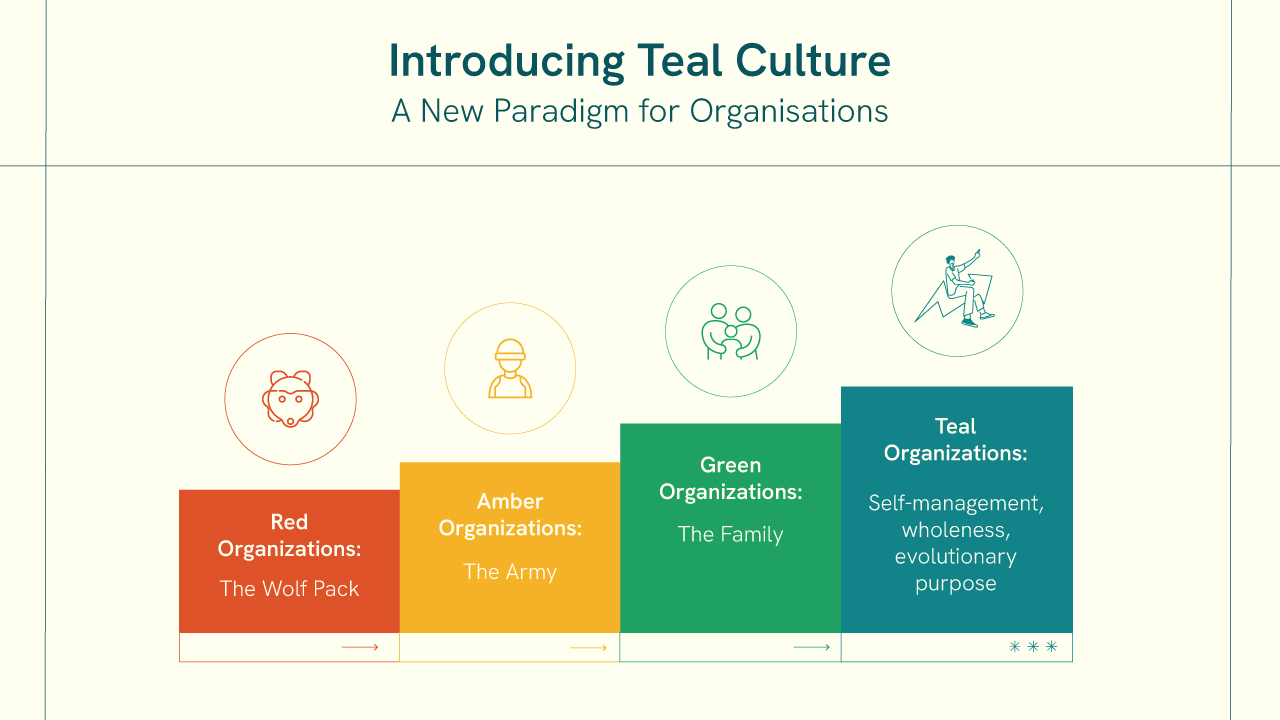What Is Teal Culture?
Teal culture is not simply a new management style rather it is an essential change of thinking that we need to make in regard to organizations and their human members. Teal is the most recent step in an evolutionary process in which organizations started in a primitive stage of tribes and evolved to the contemporary model of corporations. Breakthroughs identified as the three pillars of teal organizations are self-management, wholeness and evolutionary purpose. These values open up more accommodating, people-friendly and socially-oriented workplaces that fulfill the inner calls of individuals and the society.
The Evolutionary Journey: Red, Amber, Orange, Green, and Teal
In order to comprehend Teal, it is useful to recap the progress of how organizations have developed throughout the centuries. Each level signifies a change in human consciousness and introduces new breakthroughs and new restrictions.
Red Organizations: The Wolf Pack
- Fundamental Assumption: Power is everything. The strongest rules, and fear keeps everyone in line.
- Structure: Highly volatile, with a single leader (chief) and a tight group of loyal followers.
- Management: Decisions are made by the leader. There is little formal structure, and control is maintained through personal relationships and intimidation.
- Example: Street gangs, mafias, early conquering armies.
- Limitations: Highly reactive, unstable, and unable to scale. Innovation and long-term planning are almost nonexistent.
Amber Organizations: The Army
- Fundamental Assumption: Stability and order are paramount. There is one right way to do things.
- Structure: Rigid hierarchies, formal roles, and strict processes.
- Management: Command and control. Top management thinks, and the rest execute. Rules and discipline are central.
- Example: The Catholic Church, military, traditional public schools, government agencies.
- Limitations: Inflexible, resistant to change, and often bureaucratic. Creativity and individual initiative are stifled.
Orange Organizations: The Machine
- Fundamental Assumption: Success is measured by results and efficiency. Innovation and meritocracy are valued.
- Structure: Hierarchical but more flexible. Departments, project teams, and cross-functional initiatives are common.
- Management: Management by objectives. Leaders set goals, and employees are given some autonomy to achieve them.
- Example: Multinational corporations, Wall Street firms, charter schools.
- Limitations: Can become impersonal, driven by short-term results, and sometimes unethical. Employees may feel like cogs in a machine.
Green Organizations: The Family
- Fundamental Assumption: People matter. Empowerment, values, and community are central.
- Structure: Still hierarchical, but with a strong focus on culture and values. Decisions are pushed down to frontline employees.
- Management: Servant leadership. Managers are coaches and facilitators, not bosses.
- Example: Southwest Airlines, Ben & Jerry’s, The Container Store.
- Limitations: Can struggle with decision-making and accountability. Consensus can lead to slow progress, and power struggles may occur behind the scenes.
The Problems with Current Organizational Methods
Despite the progress made at each stage, today’s organizations even the most advanced Green ones often struggle with several persistent problems:
- Bureaucracy and Rigidity: Too many rules, slow decision-making, and resistance to change.
- Disengagement: Employees feel undervalued, unmotivated, and unable to bring their whole selves to work.
- Short-Termism: Focus on quarterly results and shareholder value at the expense of long-term sustainability.
- Silos and Politics: Departments compete rather than collaborate, leading to inefficiency and frustration.
- Burnout and Stress: High-pressure environments, lack of meaning, and little support for well-being.
These challenges are a sign of organizations which have surpassed their existing models. Due to the increasing complexity of the world, classical ways of management cannot manage to keep up any more.
Teal: A New Way Forward
Teal organizations are designed to address these challenges by embracing three fundamental breakthroughs:
1. Self-Management
- What It Means: Instead of hierarchies, Teal organizations operate with distributed authority. Teams and individuals have the power to make decisions relevant to their work.
- How It Works: There are no traditional bosses. Leadership is fluid and based on expertise and context. Information flows freely, and everyone is trusted to act in the best interest of the organization.
- Impact: Faster decision-making, greater innovation, and a sense of ownership among all employees.
2. Wholeness
- What It Means: Teal organizations encourage people to bring their whole selves to work mind, body, and spirit.
- How It Works: Emotional expression, vulnerability, and personal growth are valued. Practices like mindfulness, reflection, and open dialogue are common.
- Impact: Higher engagement, stronger relationships, and a more supportive, authentic workplace culture.
3. Evolutionary Purpose
- What It Means: Teal organizations see themselves as living organisms with a purpose of their own, rather than as machines designed to achieve a fixed goal.
- How It Works: Instead of top-down strategy, the organization listens to its purpose and adapts as it learns and grows. Decisions are guided by what feels right for the organization’s mission and values.
- Impact: Greater adaptability, resilience, and alignment with the needs of people and the planet.
How Teal Can Transform Organizational Management and People Operations
Teal culture offers a radical new approach to managing organizations and people:
- Empowerment: Employees are trusted to make decisions, reducing the need for layers of management and oversight.
- Agility: Self-managing teams can respond quickly to change, making the organization more resilient in a fast-moving world.
- Engagement: By fostering wholeness, Teal organizations create environments where people feel valued and motivated.
- Innovation: Distributed authority and open information flow encourage creativity and experimentation.
- Sustainability: Evolutionary purpose ensures that the organization remains aligned with its deeper mission and the needs of society.
Conclusion: The Promise of Teal
Teal is not only a collection of practices it is a new paradigm of thinking about organization and the individuals within them. Teal organizations represent an alternative to the restrictions of the traditional model and a way of building workplaces that are more adapted, human-scale, and purposeful. If you are fed up with bureaucracy, disengagement, and the short-term perspective, Teal is a solution that you have been looking for. It is a dream of organizations not only more competent and profitable, but also the organizations where people can flourish, innovate, and contribute to the real difference in this world.
.svg)
.png)





